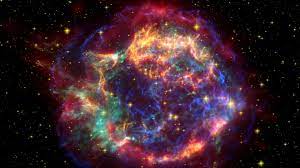In a groundbreaking discovery, researchers led by Curtin University have unearthed a rare dust particle trapped within an ancient extraterrestrial meteorite, shedding light on the enigmatic origins of stardust formed by stars other than our sun. This remarkable finding, detailed in the study titled “Atomic-scale Element and Isotopic Investigation of 25Mg-rich Stardust from an H-burning Supernova,” published in the Astrophysical Journal, marks a significant leap forward in our understanding of the cosmos.
Traversing Celestial Time Capsules: Meteorites, remnants of celestial bodies that traverse our solar system, often contain minuscule particles known as presolar grains, which offer glimpses into the distant past of other stars. Dr. Nicole Nevill, the lead author of the study, utilized cutting-edge atom probe tomography to delve into the atomic-scale composition of a dust particle, unlocking hidden insights into its parent star’s journey through space and time.
A Supernova Revelation: The analyzed particle exhibited an unprecedented ratio of magnesium isotopes, surpassing any previous discovery. This extreme isotopic composition, with a value of 3,025, hints at its formation within a hydrogen-burning supernova—a stellar phenomenon that was only recently unveiled by astronomers. Co-author Dr. David Saxey emphasizes the groundbreaking nature of this research, highlighting how it pushes the boundaries of analytical techniques and expands our understanding of astrophysical models.
Linking Lab Measurements to Cosmic Phenomena: The utilization of the atom probe in this study facilitated a level of detail previously unattainable, offering unprecedented insights into the formation processes of hydrogen-burning supernovae. Co-author Professor Phil Bland underscores the significance of bridging atomic-scale measurements in the laboratory with the discovery of a novel stellar phenomenon, marking a pivotal moment in astronomical research.
Implications for Cosmic Exploration: The revelation of stardust originating from hydrogen-burning supernovae opens new avenues for exploring cosmic events beyond our solar system. By dissecting the atomic makeup of these rare particles, researchers can unravel the mysteries of stellar evolution and cosmic nucleosynthesis, shedding light on the fundamental processes that shape the universe.
The discovery of a rare dust particle within an ancient meteorite represents a monumental achievement in the field of astrophysics. Through meticulous analysis and groundbreaking techniques, researchers have unveiled secrets hidden within the cosmic fabric, offering profound insights into the origins of stardust and the dynamic nature of our universe. As scientists continue to probe the depths of space, armed with innovative tools and unwavering curiosity, the mysteries of the cosmos are poised to unfold, illuminating humanity’s place in the vast expanse of the cosmos.
